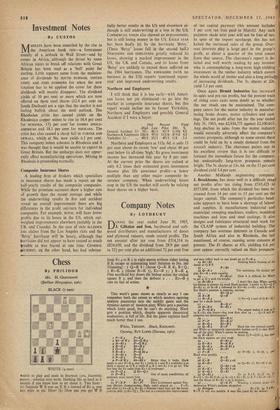Chess
By PHILIDOR
261. H. GRASEMANN (Berliner Morgenpost, 1960
BLACK (7 men)
WHITE (4 men) WHITE to play and mate in fourteen (yes, fourteen) moves ; solution next week. Nothing like so hard as it sounds if you know how to set about it. Two hints : (a) Suppose W B was on.K R 5 instead of Kt 4, you can mate in six. How? (b) How can you get W B from Kt 4 to R 5 in eight moves without either letting B K escape or stalemating him? Solution to No. 260 (Gunning) : Q—R 8 (threat Q—K R 8), B X Q; a R—K 2 (threat B—K 5), Kt—B 3; 3 R—K 4- Fine sacrificial key draws the bishop across the critical square B 3, and then the defence 2 . . . Kt—B 3 cuts its line of action.
This week's game shows as clearly as any I can remember both the extent to which modern opening analysis penetrates into the middle game and the dynamic nature of modern play; White gets a position which looks good, but he can't do anything. Black gets a position which, despite apparent theoretical weaknesses, is full of life. But the game explains itself much better than I can.
White, TRINGOV. Black, KHOLMOV.
Opening, Row LOPEZ (Havana, 1965) ▪ P—K 4 P—K 4
• Kt—K B 3 Kt—Q B 3 3 B—Kt 5 P—Q _R
4 11-41 4 Kt—B 3
B SO-0 —K a
6 R—K z P Kt 4 7 B—Kt 3 OIg 8 P—B 3 9 P—K R 3 t—Kt r Better than it. looks. Black wants to play P—B 4,K and Kt (with Q 2 and B 3"available) is as likely a square as Q 4 (with B3, B 5 and Kt 2 to go to). The fact that the Kt came from Kt t is irrelevant! 10 P—g 4 Q Kt—Q a zr P— 4. . One of many possibilities, all analysed, none clearly. best. rr ... P—B 4 Ditto. 72 PxK P Kt x PI Here Littlewood against Pen- rose (British championship, Bath, 1963) played 12 . P x P; and after 13 Kt—B 3, B—Kt 2 Penrose could have got the better position with 53 Kt—Q 5. The text is a considerable improvement
and may reflect back to cast doubt on it P—B 4.
13 KS x fit . . . Nothing better because of the threat to Q B P.
14,Q—K a PxKt . . Too ambitious. He should just play Kt—B 3 with equality.
P—K1,5f Now it is difficult for White to get at Q 5 with his knight. r5 B—Kt 5 , I don't like this. White neetMi 1
. . his bishop to protect his weak Black squares. I prefer es Kt—Q 2; B—Kt 2; 16 B—B 2 followed by Kt—Kt 1—Kt 3 and B—K J. But Black's position is superior, anyway.
aS Kt—Q a!
z6 B x B Q x B
17 B-11 4 . . 17 KL—Q 2 and rtt Q R—Q % may be a shade better. r7 . . . R--Q 11
z8 I—B 6 R— Kt r r9 P—Q R 3 . . . The sequel makes it look as if 19 B x Kt was better—but how then after tst ... Q x B will be complete his development? Kt—B 11 ao P x P Kt—K31
2l .18-4, 5 Kt—B 5 22 q— 3 R x P Black has two isolated pawns, and White an apparently impregnable bastion on Q 5—but Bled' has all the play: White's pieces do nothing. 23 R—R 2? . . . Better 23 P—Q Ki 3, but thee
the black squares are very weak.
R—Kt 3
2 Q—K4 K—R 2
R—K B 3
11—Kt 3 261 B x PIla 3
27 Px B . . . 27 P—Kt 3, R—R 3 and Black wins quickly. R x R
28 K x R Q—Kt 4 ch
29 K—B r . . . 29 Q—Kt 3?, Kt—K 7 ch.
30 K—K z
31 K—Q 2 §-7-Kt 8 ch
x Kt Kt 7 ch 32 Q—Kt 3 . . . Or 32 R xP, Q x,p ch; 33 K—Q e, Q—Kt 8 ch; 34 K—Q 2, Kt x B; 35 K P x Kt; R—NE 1 and the threat of R—Kt 7 ch is decisive.
32 • • • Q x K PI Winning a second pawn acd destroying White's position altogether. R x P ch will win quickly. A very fine g. aMe. bKytthx Be w; ?nterx KA,
33 Reaisna






























 Previous page
Previous page